How to add labels to Matplotlib images in Python
1. Add text label plt.text()
is used to add text at the specified coordinate position on the image during the drawing process. What needs to be used is the plt.text() method.
Its main parameters are three:
plt.text(x, y, s)
where x and y represent the x and y axis coordinates of the incoming point. s represents a string.
It should be noted that the coordinates here, if xticks and yticks labels are set, do not refer to the labels, but the original values of the x and axes when drawing.
Because there are too many parameters, I will not explain them one by one. Learn their usage based on the code.
ha = 'center’ means the vertical alignment is centered, fontsize = 30 means the font size is 30, rotation = -25 means rotation The angle is -25 degrees. c Set the color, alpha set the transparency. va represents horizontal alignment.
1. Example
The code adds two pieces of text to the image, one is an italic watermark of "Wide on the Journey~" with an transparency of 0.4.
The other section is to mark the closing price of the day near each vertex of the polyline.
import matplotlib.pyplot as plt plt.rcParams['font.sans-serif'] = ['SimHei'] plt.rcParams['axes.unicode_minus'] = False x = range(9) y = [5.12, 5.15, 5.13, 5.10, 5.2, 5.25, 5.19, 5.24, 5.31] c = 0.5 * (min(x) + max(x)) d = min(y) + 0.3 * (max(y) - min(y)) # 水印效果 plt.text(c, d, '旅途中的宽~', ha = 'center', fontsize = 30, rotation = -25, c = 'gray', alpha = 0.4) plt.plot(x, y, label = '股票A收盘价', c = 'r', ls = '-.', marker = 'D', lw = 2) plt.xticks(x, [ '2022-03-27', '2022-03-28', '2022-03-29', '2022-03-30', '2022-03-31', '2022-04-01', '2022-04-04', '2022-04-05', '2022-04-06'], rotation = 45) plt.title('某股票收盘价时序图') plt.xlabel('日期') plt.ylabel('价格') plt.grid(True) plt.legend() # 标出每天的收盘价 for a, b in zip(x, y): plt.text(a, b + 0.01, '%.2f' % b, ha = 'center', va = 'bottom', fontsize = 14) plt.show()
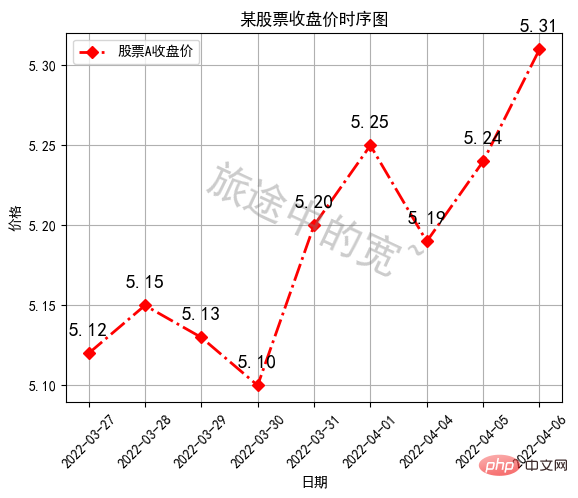
2. Add comments plt.annotate()
Based on the above example code, add comments. An annotation is an explanation of a certain location in the image, which can be pointed to with an arrow.
Add annotations using plt.annotate()method
The common parameters in its syntax are as follows
plt.annotate(str,xy,xytext,xycoords,arrowcoords)
wherestr is the string to be used in the comment, that is, the comment text; xy refers to the coordinate point being commented; xytext refers to the position where the comment text is to be written; xycoords It is the coordinate system attribute of the annotated point, that is, how to describe the coordinates of the point. The setting value defaults to "data", which is described by (x, y) coordinates. Other optional setting values are as follows, where figure refers to the entire canvas as a reference system. And axes means only for one of the axes object areas.
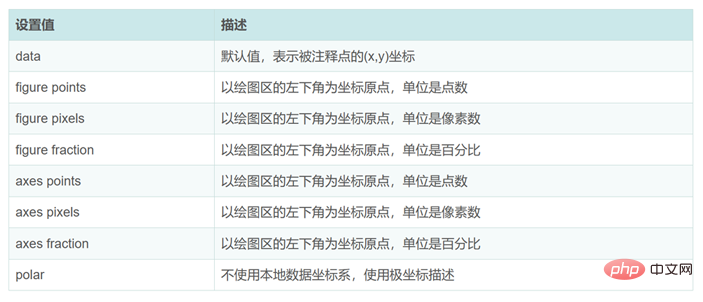
arrowprops is a dictionary used to set the properties of arrows. Parameters written outside this dictionary represent attributes of the annotation text.
The values that can be set in the dictionary are:
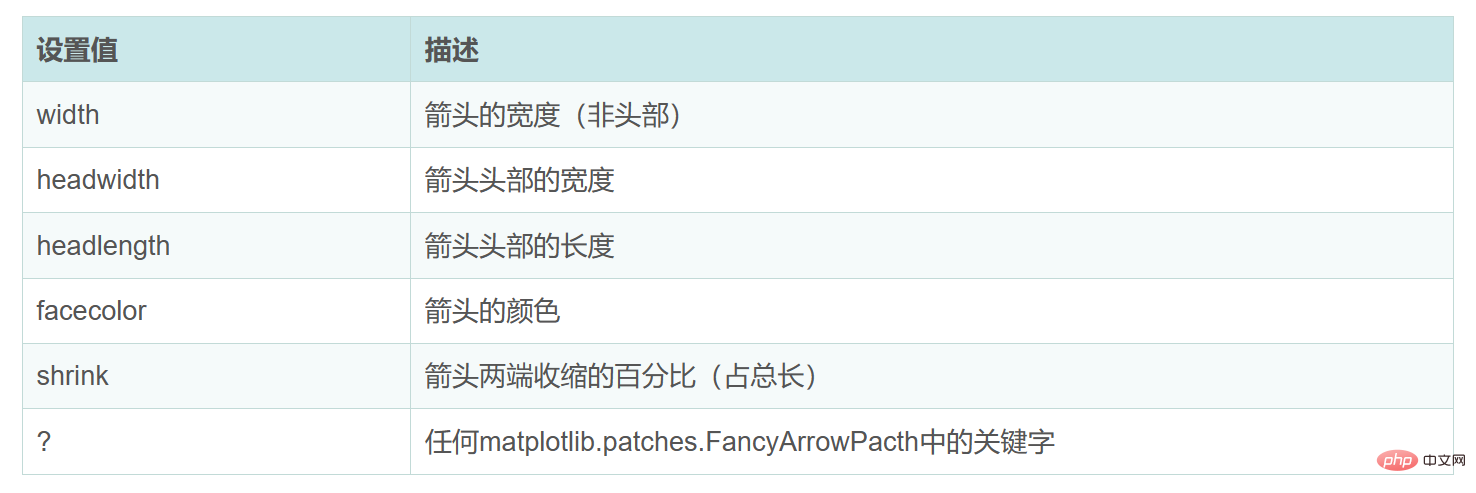
#Further explanation of these parameters: The total length of the arrow is first determined by the position coordinates of the annotated point and the annotation The length of the arrow is determined by the text position coordinates. You can further adjust the length of the arrow by adjusting the shrink key in the parameter arrowprops. shrink represents the percentage of the shortened length of the arrow to the total length (the length determined by the position coordinates of the annotated point and the annotation text position coordinates). . When shrink is not set, shrink defaults to 0, that is, no shortening. When shrink is very large, close to 1, its effect is equivalent to no shortening.
1. Example
Take marking the lowest price point on the chart as an example. Add a red arrow and the words "lowest price" at the target position.
Other parameters, such as setting the font of the annotation text, c or color represents the color, and fontsize represents the font size. Learn more about the properties and try them yourself.
import matplotlib.pyplot as plt
plt.rcParams['font.sans-serif'] = ['SimHei']
plt.rcParams['axes.unicode_minus'] = False
x = range(9)
y = [5.12, 5.15, 5.13, 5.10, 5.2, 5.25, 5.19, 5.24, 5.31]
c = 0.5 * (min(x) + max(x))
d = min(y) + 0.3 * (max(y) - min(y))
# 仿水印效果
plt.text(c, d, '旅途中的宽', ha = 'center', fontsize = 30, rotation = -25, c = 'gray', alpha = 0.4)
plt.plot(x, y, label = '股票A收盘价', c = 'r', ls = '-.', marker = 'D', lw = 2)
# plt.plot([5.09, 5.13, 5.16, 5.12, 5.09, 5.25, 5.16, 5.20, 5.25], label='股票B收盘价', c='g', ls=':', marker='H', lw=4)
plt.xticks(x, [
'2022-03-27', '2022-03-28', '2022-03-29', '2022-03-30',
'2022-03-31', '2022-04-01', '2022-04-04', '2022-04-05',
'2022-04-06'], rotation = 45)
plt.title('某股票收盘价时序图')
plt.xlabel('日期')
plt.ylabel('价格')
plt.grid(True)
plt.legend()
# 标出每天的收盘价
for a, b in zip(x, y):
plt.text(a, b + 0.01, '%.3f'% b, ha = 'center', va = 'bottom', fontsize = 9)
# 添加注释
plt.annotate('最低价', (x[y.index(min(y))], min(y)), (x[y.index(min(y))] + 0.5, min(y)), xycoords = 'data',
arrowprops = dict(facecolor = 'r', shrink = 0.1), c = 'r',fontsize = 15)
plt.show()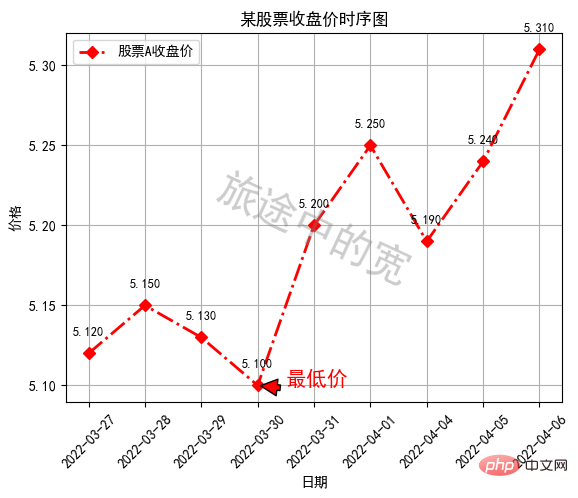
The following is a different effect. The added annotation arrow width is 3, the head width of the arrow is 10, the length is 20, shortened by 0.05, and the arrow is green , the annotation font is red. The code example is as follows:
import matplotlib.pyplot as plt
plt.rcParams['font.sans-serif'] = ['SimHei']
plt.rcParams['axes.unicode_minus'] = False
x = range(9)
y = [5.12, 5.15, 5.13, 5.10, 5.2, 5.25, 5.19, 5.24, 5.31]
c = 0.5 * (min(x) + max(x))
d = min(y) + 0.3 * (max(y)-min(y))
plt.plot(x, y, label = '股票A收盘价', c = 'k', ls = '-.', marker = 'D', lw = 2)
plt.xticks(x, [
'2022-03-27', '2022-03-28', '2022-03-29', '2022-03-30',
'2022-03-31', '2022-04-01', '2022-04-04', '2022-04-05',
'2022-04-06'], rotation = 45)
plt.title('某股票收盘价时序图')
plt.xlabel('日期')
plt.ylabel('价格')
plt.grid(True)
plt.legend()
# 标出每天的收盘价
for a, b in zip(x, y):
plt.text(a, b+0.01, '%.1f'%b, ha='center', va='bottom', fontsize=9)
plt.text(c, d, '旅途中的宽', ha = 'center', fontsize = 50, rotation = -25, c = 'r')
plt.annotate('最低价', (x[y.index(min(y))], min(y)), (x[y.index(min(y))] + 2, min(y)), xycoords = 'data',
arrowprops = dict(width = 3, headwidth = 10, headlength = 20, facecolor = 'g', shrink = 0.05), c = 'r',fontsize = 20)
plt.show()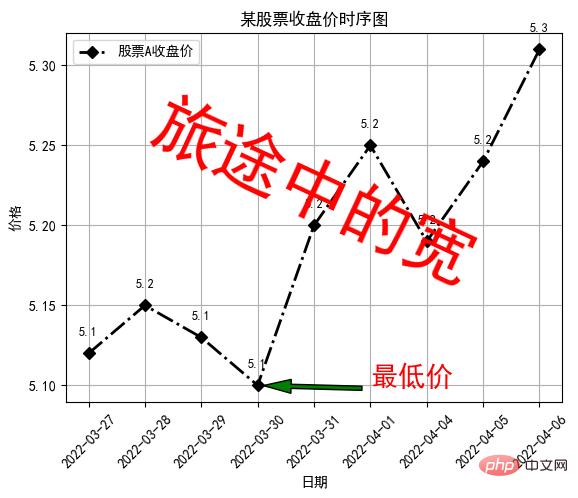
The above is the detailed content of How to add labels to Matplotlib images in Python. For more information, please follow other related articles on the PHP Chinese website!

Hot AI Tools

Undresser.AI Undress
AI-powered app for creating realistic nude photos

AI Clothes Remover
Online AI tool for removing clothes from photos.

Undress AI Tool
Undress images for free

Clothoff.io
AI clothes remover

Video Face Swap
Swap faces in any video effortlessly with our completely free AI face swap tool!

Hot Article

Hot Tools

Notepad++7.3.1
Easy-to-use and free code editor

SublimeText3 Chinese version
Chinese version, very easy to use

Zend Studio 13.0.1
Powerful PHP integrated development environment

Dreamweaver CS6
Visual web development tools

SublimeText3 Mac version
God-level code editing software (SublimeText3)

Hot Topics
 PHP and Python: Different Paradigms Explained
Apr 18, 2025 am 12:26 AM
PHP and Python: Different Paradigms Explained
Apr 18, 2025 am 12:26 AM
PHP is mainly procedural programming, but also supports object-oriented programming (OOP); Python supports a variety of paradigms, including OOP, functional and procedural programming. PHP is suitable for web development, and Python is suitable for a variety of applications such as data analysis and machine learning.
 Choosing Between PHP and Python: A Guide
Apr 18, 2025 am 12:24 AM
Choosing Between PHP and Python: A Guide
Apr 18, 2025 am 12:24 AM
PHP is suitable for web development and rapid prototyping, and Python is suitable for data science and machine learning. 1.PHP is used for dynamic web development, with simple syntax and suitable for rapid development. 2. Python has concise syntax, is suitable for multiple fields, and has a strong library ecosystem.
 Python vs. JavaScript: The Learning Curve and Ease of Use
Apr 16, 2025 am 12:12 AM
Python vs. JavaScript: The Learning Curve and Ease of Use
Apr 16, 2025 am 12:12 AM
Python is more suitable for beginners, with a smooth learning curve and concise syntax; JavaScript is suitable for front-end development, with a steep learning curve and flexible syntax. 1. Python syntax is intuitive and suitable for data science and back-end development. 2. JavaScript is flexible and widely used in front-end and server-side programming.
 Can vs code run in Windows 8
Apr 15, 2025 pm 07:24 PM
Can vs code run in Windows 8
Apr 15, 2025 pm 07:24 PM
VS Code can run on Windows 8, but the experience may not be great. First make sure the system has been updated to the latest patch, then download the VS Code installation package that matches the system architecture and install it as prompted. After installation, be aware that some extensions may be incompatible with Windows 8 and need to look for alternative extensions or use newer Windows systems in a virtual machine. Install the necessary extensions to check whether they work properly. Although VS Code is feasible on Windows 8, it is recommended to upgrade to a newer Windows system for a better development experience and security.
 Can visual studio code be used in python
Apr 15, 2025 pm 08:18 PM
Can visual studio code be used in python
Apr 15, 2025 pm 08:18 PM
VS Code can be used to write Python and provides many features that make it an ideal tool for developing Python applications. It allows users to: install Python extensions to get functions such as code completion, syntax highlighting, and debugging. Use the debugger to track code step by step, find and fix errors. Integrate Git for version control. Use code formatting tools to maintain code consistency. Use the Linting tool to spot potential problems ahead of time.
 PHP and Python: A Deep Dive into Their History
Apr 18, 2025 am 12:25 AM
PHP and Python: A Deep Dive into Their History
Apr 18, 2025 am 12:25 AM
PHP originated in 1994 and was developed by RasmusLerdorf. It was originally used to track website visitors and gradually evolved into a server-side scripting language and was widely used in web development. Python was developed by Guidovan Rossum in the late 1980s and was first released in 1991. It emphasizes code readability and simplicity, and is suitable for scientific computing, data analysis and other fields.
 How to run programs in terminal vscode
Apr 15, 2025 pm 06:42 PM
How to run programs in terminal vscode
Apr 15, 2025 pm 06:42 PM
In VS Code, you can run the program in the terminal through the following steps: Prepare the code and open the integrated terminal to ensure that the code directory is consistent with the terminal working directory. Select the run command according to the programming language (such as Python's python your_file_name.py) to check whether it runs successfully and resolve errors. Use the debugger to improve debugging efficiency.
 Is the vscode extension malicious?
Apr 15, 2025 pm 07:57 PM
Is the vscode extension malicious?
Apr 15, 2025 pm 07:57 PM
VS Code extensions pose malicious risks, such as hiding malicious code, exploiting vulnerabilities, and masturbating as legitimate extensions. Methods to identify malicious extensions include: checking publishers, reading comments, checking code, and installing with caution. Security measures also include: security awareness, good habits, regular updates and antivirus software.






